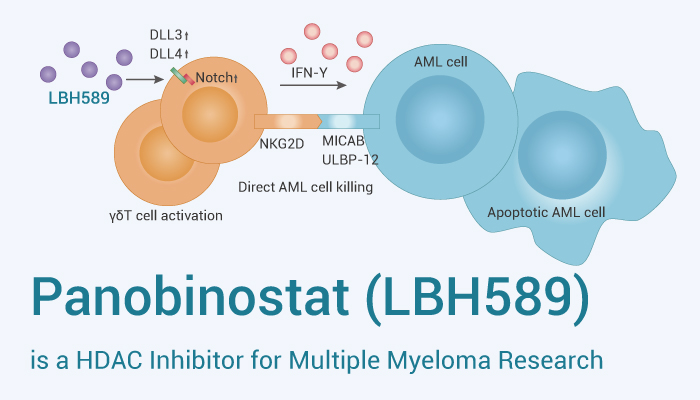HDAC inhibitors are a class of anticancer agents. HDAC inhibitors have shown antitumor effects in a variety of cancer cell lines, such as NSCLC, prostate, colon, ovarian, breast, bladder, pancreas, leukemias, and lymphomas, etc. Specifically, HDAC inhibitors acts by leading to modulation of silenced tumor suppressor genes, cell cycle arrest, terminal differentiation, and apoptosis. Therefore, Panobinostat (LBH589), an orally active pan-HDAC inhibitor, is a potent anticancer agent. Importantly, Panobinostat can induce cell apoptosis and autophagy, and used for cancer research, such as multiple myeloma, NSCLC, ALL.

Panobinostat, an orally active pan-HDAC inhibitor, can be used for multiple myeloma research.
In vitro, Panobinosta (5-20 nM) induces cell-cycle arrest and apoptosis of MOLT-4 and Reh cells in a time- and dose-dependent manner. Besides, Panobinostat also exhibits potent antiproliferative activity in human NSCLC cell lines with the IC50 ranging from 5 to 100 nM. Panobinosta (24 h) induces histone (H3K9 and H4K8) hyperacetylation, and regulates cell-cycle control genes in MOLT-4 cells. Specifically, Panobinosta increases p21 and p27 expression, but decreases c-Myc level.
Moreover, Panobinosta also shows antitumor effect in vivo. Specifically, Panobinostat (5, 10 and 20 mg/kg i.p.) demonstrates a clear benefit of decreased tumor burden in a disseminated multiple myeloma mouse model. In this model Panobinosta significantly improves Time to clinical endpoint (TTE) and reduces bone density loss. In addition, Panobinosta (10, 20 mg/kg, i.p., 5 days/week) significantly slows growth of tumor derived from Meso and NSCLC cells, with no increased mortality or obvious toxicity.
Above all, Panobinosta is an orally active pan-HDAC inhibitor, and has anticancer activity in vitro and in vivo. Moreover, Panobinosta inhibits tumor growth in various tumor model, including multiple myeloma and NSCLC model.
References:
[1] Crisanti MC, et al. Mol Cancer Ther. 2009 Aug;8(8):2221-31.
[2] Ocio EM, et al. Haematologica. 2010 May;95(5):794-803.
[3] Scuto A, et al. Blood. 2008 May 15;111(10):5093-100.